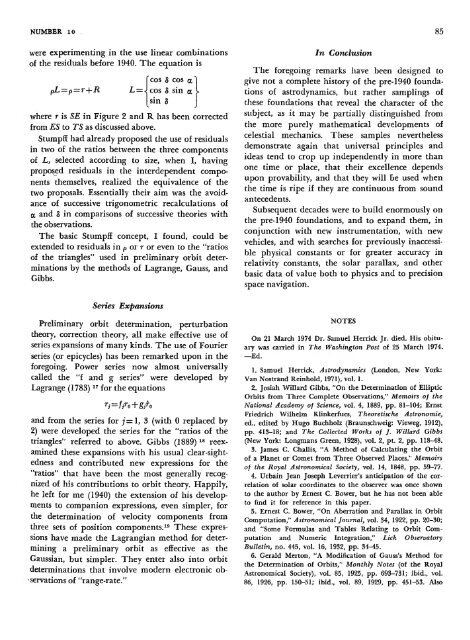FIRST STEPS TOWARD SPACE - Smithsonian Institution Libraries
FIRST STEPS TOWARD SPACE - Smithsonian Institution Libraries
FIRST STEPS TOWARD SPACE - Smithsonian Institution Libraries
You also want an ePaper? Increase the reach of your titles
YUMPU automatically turns print PDFs into web optimized ePapers that Google loves.
NUMBER 10 85<br />
were experimenting in the use linear combinations<br />
of the residuals before 1940. The equation is<br />
aL=p = r+R<br />
fcos 8 cos a<br />
L = J cos 8 sin a<br />
sin 8<br />
where r is SE in Figure 2 and R has been corrected<br />
from ES to TS as discussed above.<br />
Stumpff had already proposed the use of residuals<br />
in two of the ratios between the three components<br />
of L, selected according to size, when I, having<br />
proposed residuals in the interdependent components<br />
themselves, realized the equivalence of the<br />
two proposals. Essentially their aim was the avoidance<br />
of successive trigonometric recalculations of<br />
a and 8 in comparisons of successive theories with<br />
the observations.<br />
The basic Stumpff concept, I found, could be<br />
extended to residuals in p or r or even to the "ratios<br />
of the triangles" used in preliminary orbit determinations<br />
by the methods of Lagrange, Gauss, and<br />
Gibbs.<br />
Series Expansions<br />
Preliminary orbit determination, perturbation<br />
theory, correction theory, all make effective use of<br />
series expansions of many kinds. The use of Fourier<br />
series (or epicycles) has been remarked upon in the<br />
foregoing. Power series now almost universally<br />
called the "f and g series" were developed by<br />
Lagrange (1783) 17 for the equations<br />
and from the series for /= 1, 3 (with 0 replaced by<br />
2) were developed the series for the "ratios of the<br />
triangles" referred to above. Gibbs (1889) 18 reexamined<br />
these expansions with his usual clear-sightedness<br />
and contributed new expressions for the<br />
"ratios" that have been the most generally recognized<br />
of his contributions to orbit theory. Happily,<br />
he left for me (1940) the extension of his developments<br />
to companion expressions, even simpler, for<br />
the determination of velocity components from<br />
three sets of position components. 19 These expressions<br />
have made the Lagrangian method for determining<br />
a preliminary orbit as effective as the<br />
Gaussian, but simpler. They enter also into orbit<br />
determinations that involve modern electronic observations<br />
of "range-rate."<br />
In Conclusion<br />
The foregoing remarks have been designed to<br />
give not a complete history of the pre-1940 foundations<br />
of astrodynamics, but rather samplings of<br />
these foundations that reveal the character of the<br />
subject, as it may be partially distinguished from<br />
the more purely mathematical developments of<br />
celestial mechanics. These samples nevertheless<br />
demonstrate again that universal principles and<br />
ideas tend to crop up independently in more than<br />
one time or place, that their excellence depends<br />
upon provability, and that they will be used when<br />
the time is ripe if they are continuous from sound<br />
antecedents.<br />
Subsequent decades were to build enormously on<br />
the pre-1940 foundations, and to expand them, in<br />
conjunction with new instrumentation, with new<br />
vehicles, and with searches for previously inaccessible<br />
physical constants or for greater accuracy in<br />
relativity constants, the solar parallax, and other<br />
basic data of value both to physics and to precision<br />
space navigation.<br />
NOTES<br />
On 21 March 1974 Dr. Samuel Herrick Jr. died. His obituary<br />
was carried in The Washington Post of 25 March 1974.<br />
—Ed.<br />
1. Samuel Herrick, Astrodynamics (London, New York:<br />
Van Nostrand Reinhold, 1971), vol. 1.<br />
2. Josiah Willard Gibbs, "On the Determination of Elliptic<br />
Orbits from Three Complete Observations," Memoirs of the<br />
National Academy of Science, vol. 4, 1889, pp. 81-104; Ernst<br />
Friedrich Wilhelm Klinkerfues, Theoretische Astronomie,<br />
ed., edited by Hugo Buchholz (Braunschweig: Vieweg, 1912),<br />
pp. 413-18; and The Collected Works of J. Willard Gibbs<br />
(New York: Longmans Green, 1928), vol. 2, pt. 2, pp. 118-48.<br />
3. James C. Challis, "A Method of Calculating the Orbit<br />
of a Planet or Comet from Three Observed Places," Memoirs<br />
of the Royal Astronomical Society, vol. 14, 1848, pp. 59-77.<br />
4. Urbain Jean Joseph Leverrier's anticipation of the correlation<br />
of solar coordinates to the observer was once shown<br />
to the author by Ernest C. Bower, but he has not been able<br />
to find it for reference in this paper.<br />
5. Ernest C. Bower, "On Aberration and Parallax in Orbit<br />
Computation," Astronomical Journal, vol. 34, 1922, pp. 20-30;<br />
and "Some Formulas and Tables Relating to Orbit Computation<br />
and Numeric Integration," Lick Observatory<br />
Bulletin, no. 445, vol. 16, 1932, pp. 34-45.<br />
6. Gerald Merton, "A Modification of Gauss's Method for<br />
the Determination of Orbits," Monthly Notes (of the Royal<br />
Astronomical Society), vol. 85, 1925, pp. 693-731; ibid., vol.<br />
86, 1926, pp. 150-51; ibid., vol. 89, 1929, pp. 451-53. Also

















